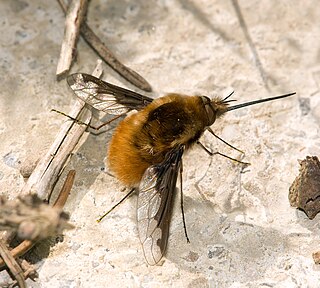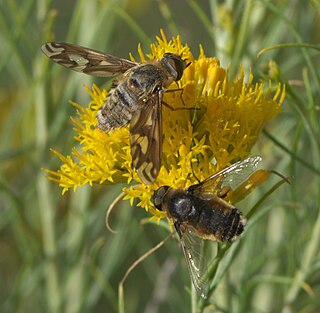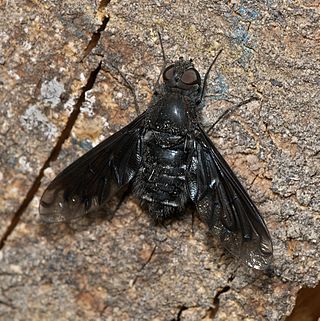
The Bombyliidae are a family of flies, commonly known as bee flies. Some are colloquially known as bomber flies. Adults generally feed on nectar and pollen, some being important pollinators. Larvae are mostly parasitoids of other insects.

Poecilanthrax willistonii, Williston's bee fly or sand dune bee fly, is a member of the Bombyliidae insect family. This family includes the bee flies, true flies that have developed Batesian mimicry characteristics to avoid predators. That is, they look like bees because that helps them avoid bee-wary predators, but they lack stingers.

The Asilidae are the robber fly family, also called assassin flies. They are powerfully built, bristly flies with a short, stout proboscis enclosing the sharp, sucking hypopharynx. The name "robber flies" reflects their expert predatory habits; they feed mainly or exclusively on other insects and, as a rule, they wait in ambush and catch their prey in flight.

Bombylius major is a parasitic bee mimic fly. B. major is the most common type of fly within the Bombylius genus. The fly derives its name from its close resemblance to bumblebees and is often mistaken for them.

Anthrax anthrax is a species of fly in the family Bombyliidae. Unlike, for example, Bombylius major, this species does not mimic a bee. The eggs are flicked by the adult female toward the entrance of the nests of mason bees. After hatching, the larvae find their way into the nests to feed on the bee larva. A. can be found in May to August throughout mainland Europe. In the Netherlands A. anthrax is a common visitor of insect hotels. It was first recorded as breeding in Britain in 2019.

Lordotus pulchrissimus is a species of bee fly in the taxonomic order Diptera and family Bombyliidae. It is also frequently referred to as the desert bee fly. Few studies have been done on the biology of L. pulchrissimus, although their behavior in the wild has been observed.
Conophorus nigripennis is a species of bee fly in the family Bombyliidae. It is found in the western United States from Arizona to Washington, and north to British Columbia, Canada.
Systoechus oreas is a species of bee fly in the family Bombyliidae. It is found in British Columbia, Canada and the western United States. Its larvae are predators of grasshopper eggs.

Systoechus is a genus of bee flies in the family Bombyliidae. There are more than 120 described species in Systoechus.
Anastoechus melanohalteralis is a species of bee fly in the family Bombyliidae. It is found in Alberta, Canada, and across the western and central United States. Its larvae are predators of grasshopper eggs.

Systoechus solitus is a species of bee fly in the family Bombyliidae. It is found in the southeastern United States from New Jersey to Florida and Louisiana. Its larvae are predators of grasshopper eggs.
Tmemophlebia coquilletti is a species of bee fly in the family Bombyliidae.
Lordotus junceus is a species of bee fly in the family Bombyliidae.
Toxophora virgata is a species of bee fly in the family Bombyliidae. It is found from Mexico through most of the western United States north to Canada. Hosts include potter wasps from the genera Odynerus and Stenodynerus.
Lordotus zona is a species of bee fly in the family Bombyliidae.
Chrysanthrax lepidotoides is a species of bee fly in the family Bombyliidae.

Chrysanthrax edititius is a species of bee fly in the family Bombyliidae.

Anastoechus hessei is a species of bee fly in the family Bombyliidae. It is found in the southwestern United States from California to Texas. Its larvae are predators of grasshopper eggs.

Systoechus candidulus is a species of bee fly in the family Bombyliidae. It is found in Ontario, Canada, and across most of the United States. Its larvae are predators of grasshopper eggs.

Anastoechus barbatus is a species of bee fly in the family Bombyliidae. It is found in Canada from the Yukon east to Ontario, and across most of the United States from Massachusetts west to California and Texas, but is absent from the southeast. Its larvae are predators of grasshopper eggs.










